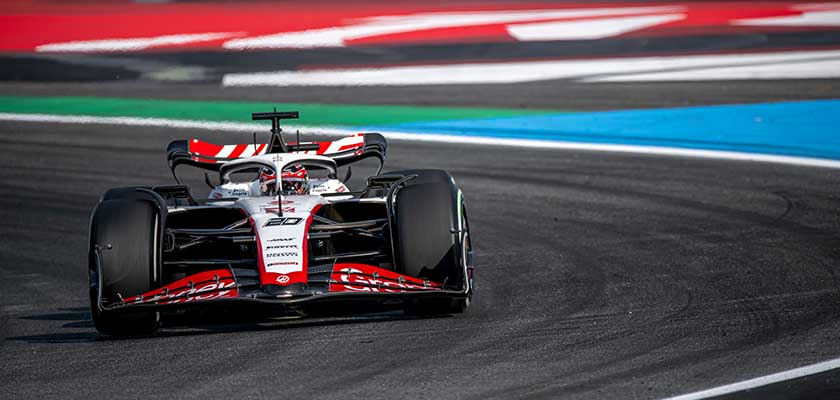F1 is the most important and prestigious sport in world motor racing. It’s home to the best drivers, circuits and cars on the planet. It’s no wonder it’s such a commercial and television ratings success.
But as with any sport, there are rules to be followed. So, in this complete and up-to-date guide, we’re going to introduce you to the rules of Formula 1.
Below, we’ll explain the basic elements of the World Championship, such as infractions, the scoring system, grid formation, qualifying and much more.
Check it out 👇
Formula 1 rules
- How does Formula 1 work?
- Formula 1 play-off criteria
- How many drivers are there in Formula 1?
- How many stages are there in Formula 1?
- How many laps are there in Formula 1?
- How many points is each Formula 1 race worth?
- How is the Formula 1 starting grid determined?
- How do pit stops work in Formula 1?
- Formula 1 flags and signalling
- What is Safety Car in Formula 1?
- What is DRS in Formula 1?
- What can’t you do in Formula 1?
- What are the penalties in Formula 1?
How does Formula 1 work?
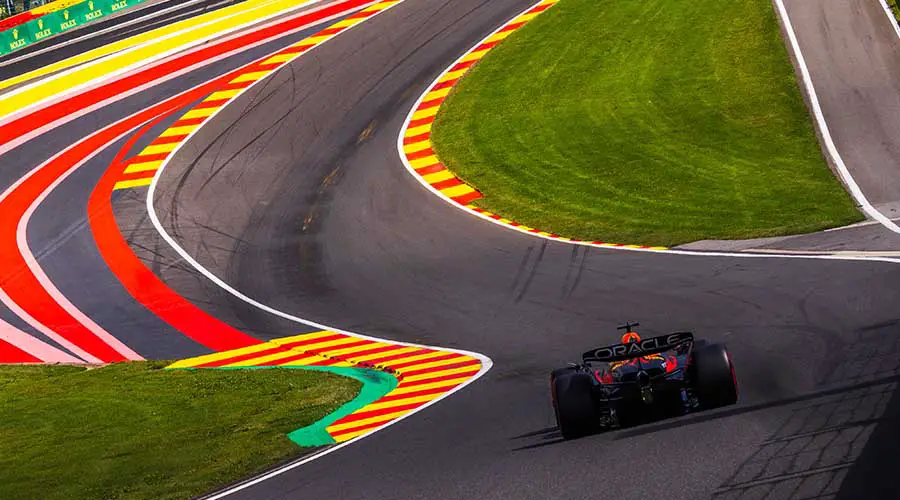
The Formula 1 World Championship is a points-based tournament. During the season, which lasts approximately 10 months, the drivers race in various events called Grands Prix (GPs).
At the end of each stage, points are awarded to the drivers. The system takes into account the place achieved in the race in question. The closer a driver gets to first place, the more points they receive.
The starting grid for a Grand Prix is set the day before in qualifying sessions. The drivers who achieve the best time get the chance to start the race from the top positions on the track.
During the races, the cars can overtake opponents, make pit stops and apply strategies.
At the end of the championship, the driver with the most points is declared the season’s champion. Red Bull Racing’s Max Verstappen currently holds the world title.
Formula 1 play-off criteria
If two or more riders finish the season with the same number of points, the first tie-breaker to determine the champion is the number of first places won during the World Championship.
If the number of first places is the same, the second tie-breaker is the highest number of second places won.
If the tie still persists, the third tie-breaker is the number of third places achieved. And so on, until the champion is determined.
How many drivers are there in Formula 1?
There are 20 drivers in 10 teams, meaning two drivers per team. Charles Leclerc and Carlos Sainz, for example, make up Ferrari. McLaren’s representatives are Lando Norris and Oscar Piastri. And so on.
How many stages are there in Formula 1?
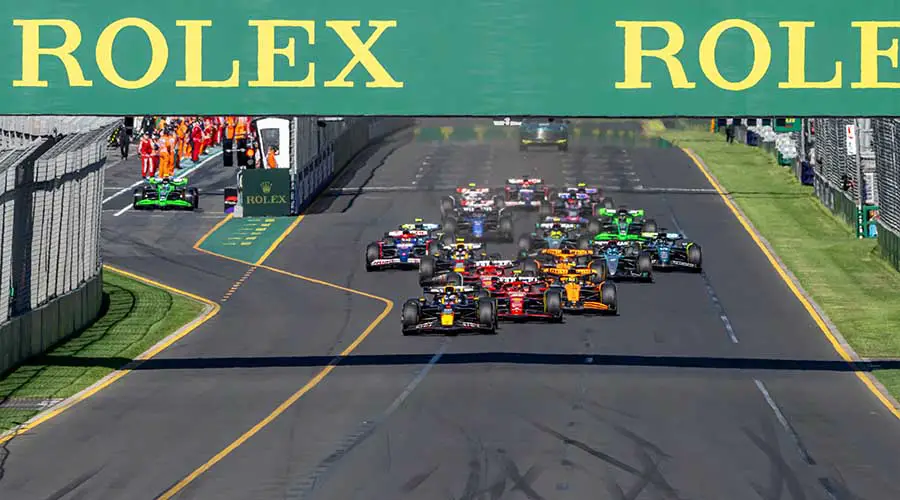
The Formula calendar is currently made up of 24 races that take place in various locations around the world, such as Italy, Japan, Qatar and Brazil.
The first race usually takes place at the beginning of March. The final Grand Prix is usually held in mid-December.
How many laps are there in Formula 1?
Each stage has a specific number of laps. The shortest race of the season is the Belgian Grand Prix (34 laps), while the longest is the Monaco Grand Prix (78 laps).
How many points is each Formula 1 race worth?
- 1st place: 25 points
- 2nd place: 18 points
- 3rd place: 15 points
- 4th place: 12 points
- 5th place: 10 points
- 6th place: 8 points
- 7th place: 6 points
- 8th place: 4 points
- 9th place: 2 points
- 10th place: 1 point
- Fastest lap: 1 point*
*An extra point is awarded to the driver who records the fastest lap of the race, provided they finish in the top ten.
How is the Formula 1 starting grid determined?
The starting grid in Formula 1 is determined by a qualifying session that takes place the day before the race, divided into three parts:
- Q1 (Qualifying 1): all the cars compete in this phase, which lasts 18 minutes. The 15 fastest cars progress to the next stage, while the rest take the remaining grid positions;
- Q2 (Qualifying 2): the remaining 15 cars compete in this phase, which lasts 15 minutes. The 10 fastest cars advance to the final stage (Q3);
- Q3 (Qualifying 3): the 10 fastest cars compete in this phase, which lasts 12 minutes. Each driver has the opportunity to set their best lap time during this period. The final starting positions are determined by the lap times in this phase, with the fastest driver winning pole position (first position).
On race day, the cars are lined up on the grid according to their positions acquired in qualifying, with pole position being first.
How do pit stops work in Formula 1?
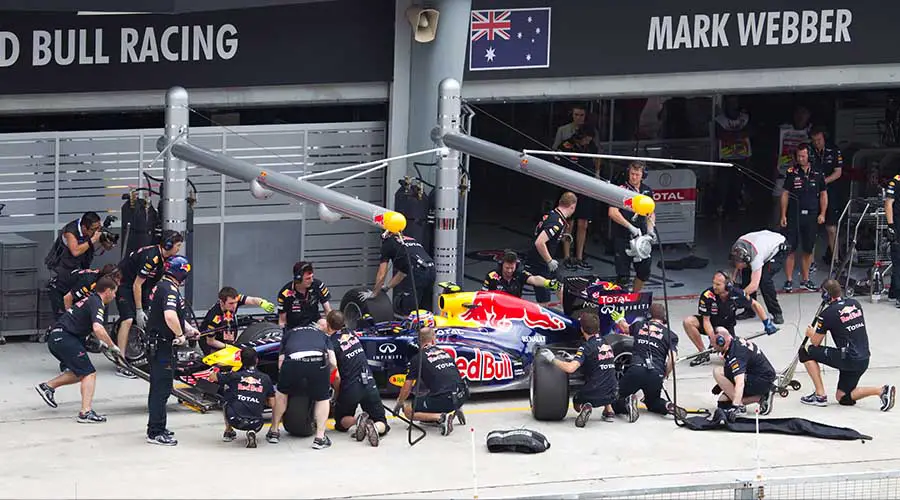
The pit stop in Formula 1 is a fundamental operation during a race, as it allows the teams to carry out quick and essential services on the cars, such as changing tyres, replacing parts and making quick adjustments.
To make a pit stop, the driver and team communicate in advance by radio. Throughout the pit lane, the driver must respect a maximum speed that varies from Grand Prix to Grand Prix.
Speed cameras monitor this speed. If a driver breaks the rules, he is penalised by losing positions in the race. In Monaco, for example, the maximum speed is 60km/h.
In general, the number of pit stops is unlimited. However, for safety reasons, the FIA can set a mandatory number on specific circuits to ensure driver safety.
This happened in 2023 at the Qatar Grand Prix. For that round, the FIA stipulated three mandatory pit stops because the pyramid-shaped grass verges at the Lusail Circuit were damaging the cars’ tyres.
The total time of a pit stop is crucial in Formula 1, as it directly influences the driver’s position in the race. The quicker the procedure is carried out, the quicker the driver gets back on the track.
Formula 1 flags and signalling
- Checkered flag: indicates the end of the race;
- Red flag: signals the immediate interruption of the session due to dangerous conditions on the track;
- Yellow flag: warns drivers of an approaching danger. In the event of a yellow flag, drivers must reduce speed and not overtake until they are back in the green flag zone;
- Green flag: informs drivers that the danger conditions have been overcome and they can resume the race at full speed;
- Blue flag: shows that a faster car is approaching to overtake a slower car. The driver who receives the blue flag must facilitate the overtaking;
- Black flag: displayed for a specific driver, it indicates that he is being penalised and must enter the pits immediately;
- Black flag with orange circle: displayed together with the car number, indicates that the car has mechanical problems and needs to be repaired;
- White flag with black stripes: indicates that the track is wet and slippery due to rain.
What is Safety Car in Formula 1?
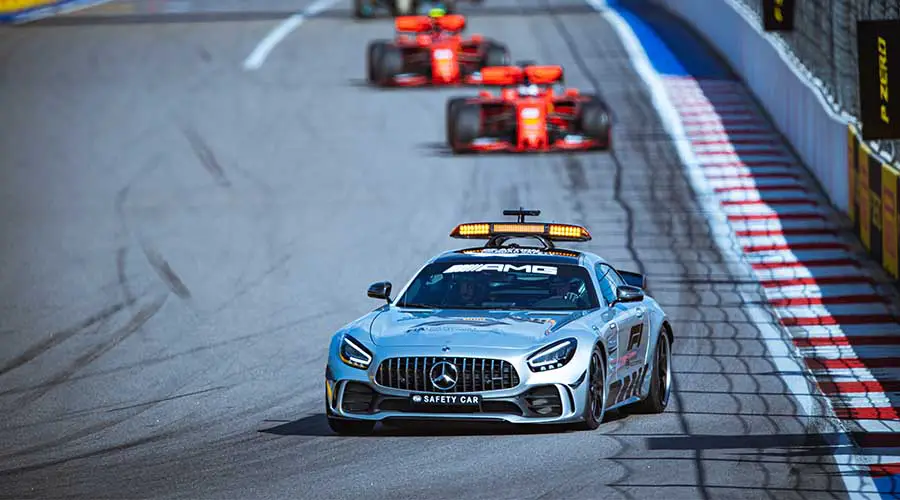
The Safety Car is a vehicle specially designated for Formula 1 races. Its purpose is to ensure the safety of drivers in certain dangerous situations.
The presence of the Safety Car occurs in response to incidents that make the track unsafe for the race to continue at its normal speed.
Some reasons why the Safety Car may be triggered include accidents, extreme weather conditions or the need to clear debris.
When the Safety Car enters the track, it leads the cars in a single file. During this period, drivers are prohibited from overtaking other cars until the Safety Car returns to the pits and the green flag is displayed, indicating the resumption of the race at full speed.
What is DRS in Formula 1?
DRS, or Drag Reduction System, is a technology introduced in Formula 1. With it activated, cars open up their rear wing and are able to overtake their rivals more easily.
This feature can only be used on specific stretches, when the driver is less than a second behind the car in front of him. Each Grand Prix has DRS zones, usually on the straights, which are favourable for overtaking.
The Drag Reduction System is automatically deactivated when the driver applies the brakes, moves too far away from his opponent or leaves the DRS zone.
In some races, the use of DRS may be restricted in the first few laps of the race to avoid early overtaking. The same applies to races with adverse weather conditions, in order to guarantee driver safety.
What can’t you do in Formula 1?
- A driver may not make excessive defensive movements to block a competitor during an overtaking attempt. Sudden and abrupt manoeuvres to defend the position may result in penalties;
- A driver who is being overtaken must maintain a consistent and predictable racing line. It is not permitted to deliberately block the car that is trying to overtake;
- Drivers must not overtake outside the track limits. If this happens, he may be forced to give back the position;
- Deliberate touching between cars during overtaking is not permitted. Incidents of excessive contact may be investigated by the race stewards and could result in penalties;
- With the Safety Car on the track, overtaking is prohibited until the green flag indicates the restart of the race.
What are the penalties in Formula 1?
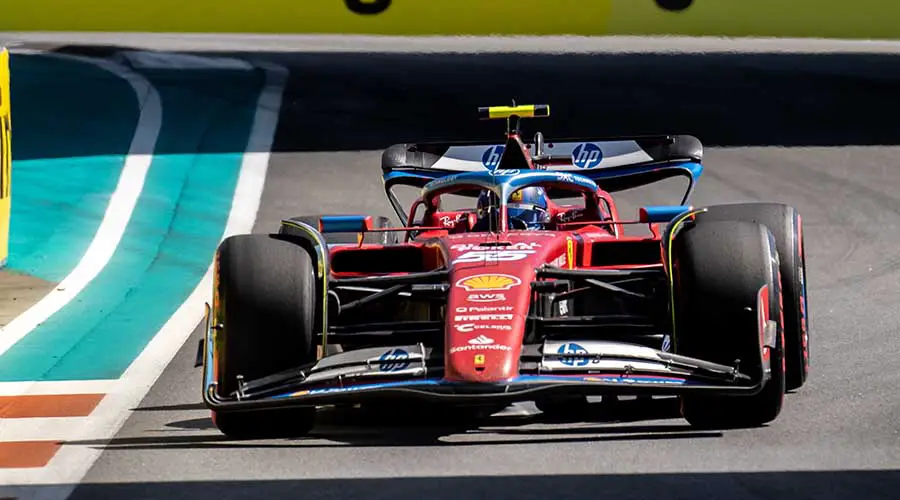
In Formula 1, penalties are applied when drivers or teams break the rules laid down by the FIA. The sanctions, therefore, are intended to ensure driver safety, promote fair racing and preserve the integrity of the sport. Check out the main types below:
- Warnings: in some situations, stewards may choose to give a verbal or written warning to a driver or team instead of imposing an immediate penalty. However, multiple warnings can lead to harsher penalties;
- Time addition: race stewards can impose a time addition to a driver’s final result as a penalty for an offence. This can happen, for example, if a driver overtakes outside the track limits and gains an advantage;
- Grid penalty: a driver can receive a penalty that affects their position on the starting grid. This can occur in cases of offences committed during qualifying or as a result of accumulated penalties from previous races;
- Drive-through: a driver may be forced to pass through the pits during the race without making a full stop. This penalty is usually imposed for offences such as early starts or deliberate touching;
- Stop-and-go: similar to drive-through, stop-and-go is a penalty where the driver must enter the pits and remain stationary for a certain period before resuming the race;
- Loss of licence points: race stewards can award penalty points on a driver’s driving licence. If a racer accumulates a certain number of points in a specific period, he could face suspension;
- Exclusion from results: in serious cases, the stewards can decide to exclude a driver or team from the results of a race or championship.
Now you know all the rules of Formula 1 and are more than ready to watch the races in this incredible sport 👊
Visit our website every day for more content on sports, e-sports, games and betting! It’s always a pleasure to welcome you here.


